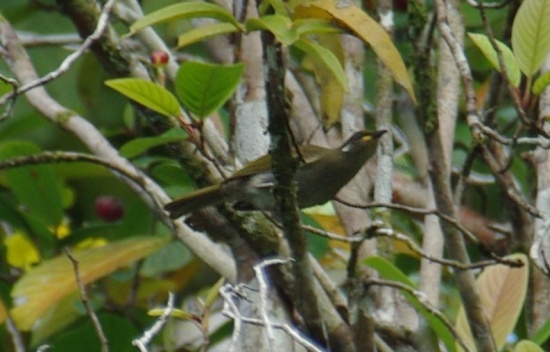Alternative names: White-eared Meliphaga; Scrub White-eared Honeyeater; Scrub White-eared Meliphaga; Southern White-eared Honeyeater; Southern White-eared Meliphaga; White-marked Honeyeater; White-marked Meliphaga; Scrub White-marked Honeyeater; Scrub White-marked Meliphaga; Scrub White-eyed Honeyeater; Southern Honeyeater; Diamond Honeyeater; Scrub Mountain-honeyeater; Scrub Mountain-meliphaga
- Microptilotis albonotatus
Meliphaga albonotata
Identification
17-19 cm.
- Greyish olive top and side of head, neck and upperbody
- Blackish lores
- White lower ear-coverts creating small rounded ear-patch
- Bright yellow or orange-yellow gape merging with paler rictal streak (not meeting ear-patch)
- Dark brown tail feathers with yellowish-olive outer edges
- Uniform light olive-grey underparts, pale yellow tinge or diffuse streaking on breast and belly
- Olive-yellowish or buff underwing-coverts
- Black to brownish black bill
Sexes alike, males are slightly larger than females.
Juveniles have a yellow tinge in ear-patch, dark olive-brown upperparts and irregular darker olive-brown band across breast.
Similar species
Has brighter green crown and upperparts than Forest Honeyeater. Rictal streak is yellowish or creamy (not white), the underparts are plainer, yellowish or yellowish-olive fringes and edges on upperwing and tail, the gape richer yellow
Distribution
Found in hills and lower mountains of New Guinea (Vogelkop, Weyland, Nassau and Oranje Mountains, Huon Peninsula, and south-central and southeastern hills).
Fairly common to abundant in its range.
Taxonomy
This is a polytypic species[1] consisting of 2 subspecies.
Treated as monotypic by Gill and Donsker.
Subspecies
- M. a. setekwa
- Foothills of south-central New Guinea
- M. a. albonotatus
- Foothills of southern New Guinea
Habitat
Moist lowland forests and montanes. Usually in disturbed habitats like secondary growth, also in grasslands, plantations and town and village gardens.
Occurs mainly in foothills and lower mountains, less often in lowlands. From sea-level up to 2000 m, occasionally higher.
Behaviour
Diet
Feeds on insects, nectar and some fruit.
Forages mainly in the understorey, usually singly or in pairs.
Breeding
Breeds in dry season and middle of wet season. The nest is a neat cup made of fine fibres, moss, grasses, bark and animal silk. It's suspended 1 to 5 m above the ground from a horizontal fork in a small tree, shrub or bamboo thicket. Lays 1 to 2 eggs.
Movements
Probably a resident species.
References
- Clements, J. F., T. S. Schulenberg, M. J. Iliff, S. M. Billerman, T. A. Fredericks, J. A. Gerbracht, D. Lepage, B. L. Sullivan, and C. L. Wood. 2021. The eBird/Clements checklist of Birds of the World: v2021. Downloaded from https://www.birds.cornell.edu/clementschecklist/download/
- Del Hoyo, J, A Elliott, and D Christie, eds. 2008. Handbook of the Birds of the World. Volume 13: Penduline-tits to Shrikes. Barcelona: Lynx Edicions. ISBN 978-8496553453
- Gill, F and D Donsker (Eds). 2014. IOC World Bird Names (version 4.1). Available at http://www.worldbirdnames.org/.
Recommended Citation
- BirdForum Opus contributors. (2024) Scrub Honeyeater. In: BirdForum, the forum for wild birds and birding. Retrieved 29 April 2024 from https://www.birdforum.net/opus/Scrub_Honeyeater
External Links
GSearch checked for 2020 platform.




